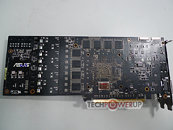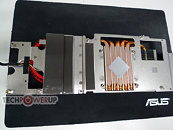- Joined
- Oct 9, 2007
- Messages
- 47,612 (7.45/day)
- Location
- Dublin, Ireland
| System Name | RBMK-1000 |
|---|---|
| Processor | AMD Ryzen 7 5700G |
| Motherboard | Gigabyte B550 AORUS Elite V2 |
| Cooling | DeepCool Gammax L240 V2 |
| Memory | 2x 16GB DDR4-3200 |
| Video Card(s) | Galax RTX 4070 Ti EX |
| Storage | Samsung 990 1TB |
| Display(s) | BenQ 1440p 60 Hz 27-inch |
| Case | Corsair Carbide 100R |
| Audio Device(s) | ASUS SupremeFX S1220A |
| Power Supply | Cooler Master MWE Gold 650W |
| Mouse | ASUS ROG Strix Impact |
| Keyboard | Gamdias Hermes E2 |
| Software | Windows 11 Pro |
ASUS has been readying its Republic of Gamers (ROG) Matrix HD 5870 graphics card. Earlier, the card was pictured fully assembled. Sources shared pictures of the card taken apart, showing its PCB and cooling assembly from the inside, which tells us a lot about this card. To begin with, ASUS engineered this card from scratch, with its own PCB and cooler designs, and choice of components. The card comes overclocked out of the box, and also promises overclocking headroom higher than the reference design. It features 2 GB of GDDR5 memory. The PCB reveals a strengthened VRM. There is a 10-phase vGPU and 2-phase vMem, with independent voltage controllers. Power is drawn in from two 8-pin power inputs.


ASUS has used hand-picked low-leakage AMD Cypress GPUs. Out of the box, the core is clocked at 900 MHz, with memory clocked at 1200 MHz. Besides the strong VRM, ASUS used an ML capacitor for conditioning the GPU voltage. An additional controller engineered by ASUS can monitor a number of parameters including voltages, clocks, fan-speeds, and GPU load (something new for ATI GPUs). Voltages can be controlled using the provided software. The software also allows control over the graphics card's memory timings. The GPU has consolidated voltage measure points to make it easy to manually measure them.


While the cooling assembly looks aesthetically pleasing on the outside, it's elaborate on the inside. ASUS used five copper heat pipes that make direct contact with the GPU core, to quickly transfer heat onto a dense aluminum fin array. The leaf-blower by ASUS is thicker and more turbulent. This design is expected to churn out an air-pressure 22 percent higher than what AMD's reference blower manages. Since the SKU has been announced by the company, the ROG Matrix HD 5870 will reach stores soon.


View at TechPowerUp Main Site


ASUS has used hand-picked low-leakage AMD Cypress GPUs. Out of the box, the core is clocked at 900 MHz, with memory clocked at 1200 MHz. Besides the strong VRM, ASUS used an ML capacitor for conditioning the GPU voltage. An additional controller engineered by ASUS can monitor a number of parameters including voltages, clocks, fan-speeds, and GPU load (something new for ATI GPUs). Voltages can be controlled using the provided software. The software also allows control over the graphics card's memory timings. The GPU has consolidated voltage measure points to make it easy to manually measure them.


While the cooling assembly looks aesthetically pleasing on the outside, it's elaborate on the inside. ASUS used five copper heat pipes that make direct contact with the GPU core, to quickly transfer heat onto a dense aluminum fin array. The leaf-blower by ASUS is thicker and more turbulent. This design is expected to churn out an air-pressure 22 percent higher than what AMD's reference blower manages. Since the SKU has been announced by the company, the ROG Matrix HD 5870 will reach stores soon.


View at TechPowerUp Main Site













